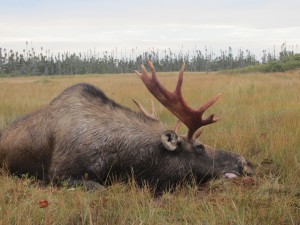The study of moose movements can help you come up with some good ideas as to the patterns and travels of moose in a given area. By learning how much moose travel during the daylight and at nighttime, a hunter may improve his moose hunting techniques. Information from the book Ecology and Management of the North American Moose indicates that bull moose not in the rut don’t travel very far in a 24-hour period. Although the movements of bull moose increase dramatically during the peak of the rut, the movement of cow moose decreases.
What does this mean to the moose hunter? When out moose hunting and you come across moose tracks made overnight or which appear to be not too old, don’t be quick to dismiss these signs. The moose may not be as far away as you might think. Once you have determined the direction of travel, follow the tracks on a parallel line on the downwind side. Every once in a while approach the moose tracks to determine the direction of travel. Remember, moose have the habit of circling to the downwind side before bedding down to monitor the approaching predators that may follow his track. If you do find reasonably fresh moose tracks, it may be advisable to follow them or at least set up and do some calling. The moose may be closer than you think!
Visit our web site: www.sprucepondhunting.com
Toll-free: 1-844-277-7823
E-mail: info@sprucepondhunting.com
Source: Moose Hunting Tips: The Ultimate Guide to Moose Hunting.




